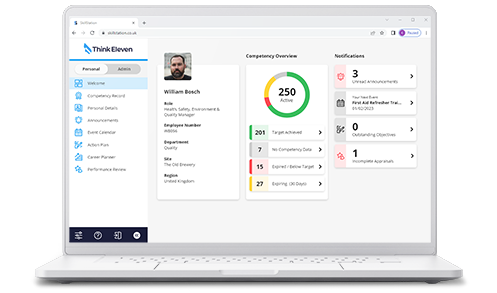In todays post, we'll be looking at some tips for creating and supplying an eLearning storyboard to your designer or developer.
eLearning can be a great way to deliver content and training to your workforce. When done well, it will streamline your training & development, and therefore save money.
However, creating effective eLearning can be tricky. It requires a slightly different approach to building a typical training presentation.
This guide gives some direction on creating an eLearning storyboard. It should be considered by your training material authors to:
- Clearly define your expectations and aspirations from the training material.
- Provide a solid foundation for collaboration with stakeholders and subject matter experts to build an excellent course.
- Assist with timescale expectations (e.g., time to convert into eLearning).
- Enable accurate cost mapping, especially if requesting quotations from external eLearning authors.
Creating your eLearning storyboard
We’ve outlined some key points when creating your storyboard. This will help you, your stakeholders, course designers and developers hit the ground running when you start to build the course.
Know the overall goal of the course
Understanding this is essential. Consider the primary and secondary learning objectives and what you want learners to take away by completing the course.
Having a clear goal in mind will define and guide the rest of the storyboarding process and assist with staying focused as the course grows.
Define learning objectives
Clearly defining learning objectives is the key to a successful course. Thoroughly understanding objectives will require working with subject matter experts to help define exactly what needs to be covered in the course and what doesn’t.
This will also allow you to determine the amount of information you are working with in advance and will ultimately save time later in the process. Adding, removing, or editing content on a course that is half-built can be complex, and therefore may cause increased costs and delays.
Define the audience
Who is the course aimed at? The complexity of the content needs to match their knowledge level, ensuring learners don’t find it either too complex or too simplistic. Complexity causes frustration but making it too easy may cause disinterest and complacency.
This will also help collaboration with a subject matter expert as they’ll be able to help define what content will be a suitable level for the learner.
Also factor in the physical environment that learners will be in when they are completing the course:
- Are they on a computer in a training room with sound?
- Are they at a noisy workstation with a tablet and no sound?
- Are they working from home, and have the appropriate technology?
Use a storyboard template
Storyboards help to define the course structure. For example, a typical structure may be an introduction with an outline of learning objectives followed by a sequence of modules covering each objective or aspects of an objective. This can then be completed with an assessment to check learners have gained the knowledge required.
With this framework in place, it will give you a clearer picture of what content (images, video) will need to be gathered and what further contributions you’ll need from subject matter experts.
There are many free storyboard templates to be found online – all varying in complexity and quality. We’ve developed our own that we can supply you with upon request here.
Define any assessment criteria
With course objectives established, the next step is defining any assessments.
Assessments needs to align with the learning objectives to ensure your learners become equipped with the knowledge they need. This will further clarify the main course content, as you will need to ensure it equips learners with the knowledge that they need to successfully complete the assessment.
Writing a script
When writing the text content for your eLearning course, here are a few things to consider.
- The ability of the learner.
- Is the language too complex or simplistic?
- Do you need to explain any acronyms?
- Can your course cater for different levels of ability by allowing users to get additional information/clarity if needed?
Other considerations;
- Will your course have voiceover audio? If so, this may affect your style of writing.
- How will any text combine with images? Can learners be shown an image or video with a concise caption, instead of a paragraph?
- If using voiceover, it’s important not to simply display the exact same words on-screen. People can read faster than the narrator will speak and may get bored of waiting. However, consider the availability of captions for people with hearing impairments.
Sense-check your script
Share the completed script with different people in your organisation and gather feedback. It is much easier (and therefore cheaper) to make corrections now before it is transformed into an eLearning course.
Sample audiences could include:
- Other subject matter experts
- Team leaders or managers
- New starters
Supplying Images
Images are a great way of making your course interesting and informative. Using your own images also provides additional context to the learner. Alternatively, there are many image libraries online where photographs or illustrations can be purchased cheaply.
When supplying images there are a couple of points to keep in mind:
- Beware of copyright! Images taken from the internet that you don’t own could be an infringement of copyright law.
- Taking your own photos should be done on the best camera you have available. If shooting images on a phone camera, try to use a tripod or other method of keeping the camera steady – this will ensure a clear, non-blurry image.
- When exporting and sending images, ensure that they are at the original file size and resolution. This will give your eLearning developer an image that can be easily edited and resized to suit your course design.
- Name your files. It’s a small difference but can save development time and makes referencing your images in storyboard easy to understand.
- Don’t embed images into word and PowerPoint. Sending images this way subjects them to image compression – which means a significant loss of quality. Name them clearly and refer to them in the appropriate places (e.g., your storyboard or script).
- Ideally images can be collated together in a folder, zipped, and sent. A file transfer service such as DropBox or SharePoint may be used if the file size is particularly large.
Supplying video
The points covered in the images section are also applicable to supplying videos, but with a few extra things to consider:
- Be mindful of keeping the camera steady. Any shots that require the camera to move can be very difficult to keep steady without the right equipment.
- Are you including sound in your video? Without using the correct microphone any audio may sound distant and too quiet.
The final package
Your completed course should aim to establish structure and give your eLearning designer the ability to hit the ground running but doesn’t necessarily need to be the exact final product.
Further reading & learning
There are many sources of free information on the internet to help give further guidance to building your eLearning storyboard. One particularly useful one is the eLearning Essentials course found on LinkedIn Learning.
LinkedIn Learning - eLearning Essentials
Think Eleven can also help with creating images, illustrations and animations if needed.
We’re also on hand to help answer any questions about this process – feel free to reach out to us.





